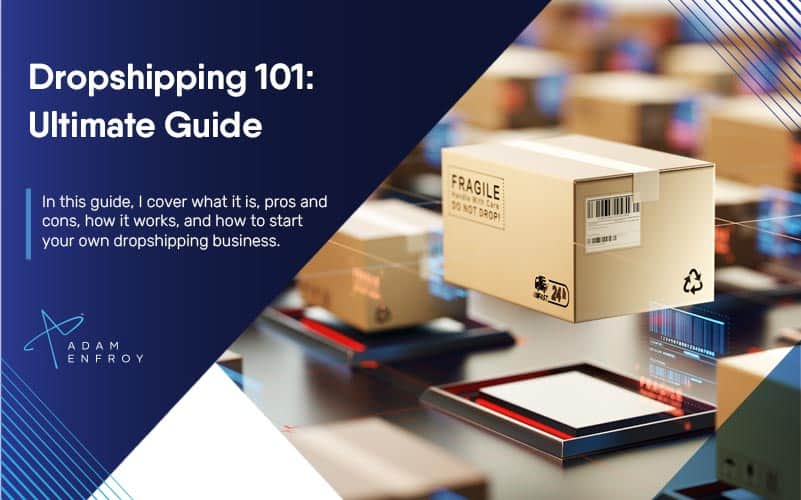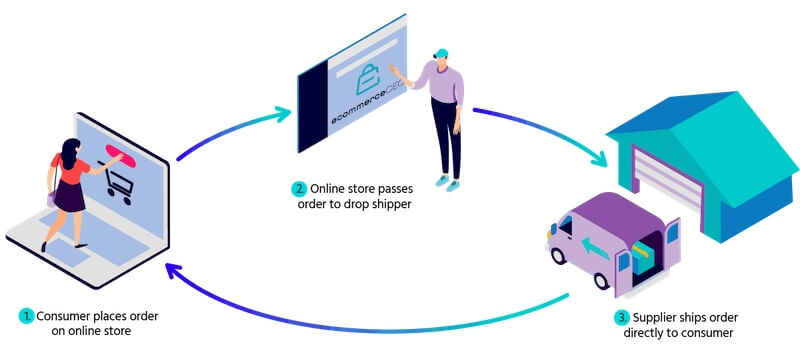
Everyone is looking to start a side hustle these days. In fact, according to statistics, as many as 44 million Americans have a side hustle. And this where dropshipping comes into the game.
If you want to earn a decent passive income by launching your own ecommerce store but are skeptical about the complexities of inventory management, shipping, and order fulfillment, then dropshipping is the perfect option.
However, if implemented correctly, dropshipping can help you make a lot of money.
In this ultimate guide to dropshipping, we cover everything from what it is, how to get started, the pros and cons, mistakes to avoid, to how to run and grow a successful business.
Let’s get started.
Disclaimer: This article contains affiliate links that I receive a small commission for at no cost to you. However, these are merely the tools I fully recommend when it comes to starting a dropshipping business. You can read my full affiliate disclosure in my privacy policy.
What is Dropshipping?
Dropshipping is a retail fulfillment method where online stores market products but don’t own or maintain an inventory. Instead, customers purchase items from retailers but the manufacturer handles the shipping.
This is the biggest differentiator between this model and and a traditional ecommerce business – no need to handle inventory and shipping.
This is huge, as it allows almost anyone with an internet connection, a website (and some marketing skills) to open their own online storefront and get a cut of all sales they generate.
In addition, it’s as easy as ever to source products through a third-party supplier as business owners.
This ensures that the target audience finds what they’re looking for.
While the profit margins aren’t usually as high with drop shipping for store owners, many of them focus on high AOV products to make up for it.
Let’s look at the old model of retail vs. dropshipping.
Let’s consider someone making a purchase at Best Buy, one of the biggest electronics retailers in the US.
A customer walks into Best Buy, buys a new smart TV, pays their bill, and walks out. In this case, Best Buy has to purchase the TV wholesale from the manufacturer and store it in their retail location so that the buyer can preview it and take it home.
Not only that, but they also have to pay for retail space to keep it on display, hire workers to move the products from storage, hire workers to collect payments at the cash register, hire security guards, and (in the case of ordering from BestBuy.com), ship the TV themselves.
It’s a lot of work and all of the manual labor drastically cuts down on profit margins.
Dropshipping cuts out a lot of these steps.
In this instance, a customer visits an online retailer and purchases a Samsung TV. The dropshipper then sends the customer and order information to Samsung and that’s it.
No workers to hire, no products to display, and no physical retail space.

It’s inexpensive to start this type of business – all you need is some online software and access to dropshipping suppliers.
Have a look at these dropshipping statistics:
- In the year 2016-2017, around 23% of all online sales, which amounts to $85.1 billion, were made via drop shipping.
- In fact, even Amazon made 34% of its total sales via drop shipping, way back in 2011. The numbers have only increased every year.
- And it’s a very lucrative medium of conducting business. A study proves that manufacturers who do business with dropshipping retailers end up earning 18.33% more profit than those who rely on more conventional channels.
Here the exact steps required in a drop shipping purchase:
- You (the retailer) market products online.
- You attract an online consumer to make a purchase.
- You forward the buyer information to the manufacturer, wholesaler, or distributor, along with order details.
- The manufacturer ships the items to the customer.
With this model, the customer is not aware that the online store they purchased from did not actually ship the products. This is especially true if the manufacturer adds retailer packing slips in the boxes.
Overall, dropshipping requires a good deal of trust and a long-term partnership between retailers and distributors.
The Importance Of Defining Your Niche
Starting a drop shipping business is relatively easy. You have to:
- Sign up for an ecommerce platform and design your website.
- Sign up with a dropshipping supplier and choose your products.
- Add or sync the product to your store.
- Set up your tax and shipping settings.
- Test your checkout process.
- Launch your website.
That’s about it. As long as you have a functional website with a home page, product pages, and the ability to buy products, you have an online store.
For example, you can use an ecommerce tool like Shopify, automatically sync your products with a dropshipping site like Inventory Source, and get your website up in a day or two.
If you need help setting up your drop shipping store, one great resource is Fiverr. They have a dedicated area of dropshipping freelancers who can help with anything from setting up your ecommerce platform, designing your store, and syncing your inventory.


0 Comments